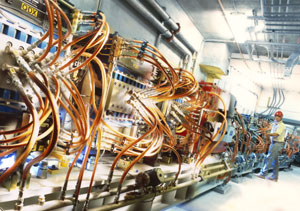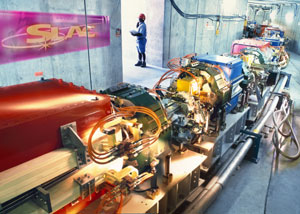SPEAR3
Dedication January 29, 2004
Pat Dehmer's Talk:
Almost precisely se
ven years ago, the Office of Basic Energy Sciences
commissioned the first review of its four light sources. The review
was headed by Bob Birgeneau, who was then the Dean of Science at
MIT. The committee members were among the most distinguished researchers
in the country. However, very deliberately, only a fraction of them
knew about the light sources. Some of the others were skeptics.
A few were hostile, primari
ly because of the large budgets associated
with construction and operation of the light sources.
We asked this committee
ten questions. The first question, the most important question,
was:
"What has been
the scientific impact of synchrotron radiation based research
during the
past decade, and what is it expected to be during the
next decade?"
Of the four light
sources under review, two had been commissioned quite recently.
They were shiny and new, but they had only the briefest history
of operations behind them and, thus, they could not answer the
first part of the question from their own experiences.
By contrast, at the
time of the review, SSRL had been operating for more than 20 years.
It had a stunning portfolio of scientific and technical accomplishments,
and, moreover, it had assembled a prestigious faculty and cadre
of users that together described the science impacts from SSRL
research and articulated a grand vision of the future.
It is not an understatement
to say that the conclusion of the review, which strongly endorsed
synchrotron radiation research and recommended that the two older
facilities be upgraded, is due in large part to the dazzling performance
of the researchers and faculty at SSRL.
"The most straightforward
and most important conclusion of this study is that over the past
20 years in the United States synchrotron radiation research has
evolved from an esoteric endeavor practiced by a small number
of scientists primarily from the fields of solid state physics
and surface science to a mainstream activity which provides essential
information in the materials and chemical sciences, the life sciences,
molecular environmental science, the geosciences, nascent technology
and defense-related research among other fields. The user community
at U.S. synchrotron facilities continues to grow exponentially,
having reached more than 4,000 on-site users annually in FY97.
The research carried out at the four D.O.E. synchrotron sources
is both very broad and often exceptionally deep."
At that time, SSRL
proposed a sweeping upgrade, which would be carried out in less
than a year and at a very modest cost. It seemed too good to be
true. It was certainly too good to pass up. Rather quickly, DOE
and NIH partnered to fund it.
Today, we are celebrating
several things: (1) the successful completion of
the upgrade.
(2) the collaboration between DOE and NIH that made it happen,
and (3) most of all, we are celebrating the hundreds of staff
at SLAC and SSRL who first envisioned the upgrade and then worked
to complete it on time and within budget.
Once our oldest light
source, SSRL is now our newest and shiniest. And its future is
bright indeed.
In addition to my
congratulations, Ray Orbach, the Director of the Office of Science,
and Spencer Abraham, the Secretary of Energy, also send to all
of you their best wishes and congratulations on the completion
of this project.
Last month, when the
Department
of Energy officially closed the books on the SPEAR3
upgrade project, I joked with the folks here that, at the dedication
ceremony, I expected to see 100 mA of current circulating in the
ring. That, of course, was an absurdly unrealistic goal, and we
all had a good laugh. Well, it was achieved.
This brings me back
again to the team that made it hap
pen on time, within budget,
and meeting all technical specs. All of the staff who were part
of that team are the heros of this project. Keith will talk about
many, but I would like to single out one. And that one is Tom
Elioff, who served as project manager.
[Tom up on stage.]
Tom has been a leader in the design, construction, and operation
of major accelerator facilities for very nearly half a century,
first at Lawrence Berkeley National Laboratory and most recently
here at SLAC.
He has had leadership
roles for the Bevatron; the Bevalac; PEP I; Berkeley's National
Center for Advanced Materials (NCAM), which inclu
ded the Advanced
Light Source (ALS); the Superconducting Super Collider; PEP II;
and now the SPEAR3 Upgrade project.
Tom Elioff has a remarkable
ability to get good people to work with him and to inspire their
very best efforts.
On behalf of the Secretary
Abraham, I have the g
reat honor to present you with the U.S. Department
of Energy's Distinguished Associate Award "for your many
accomplishments and leadership in the project management of major
accelerator consruction for the Department of Energy. Especially
noted are your contributions to the PEP I, SSC, PEP II, and SPEAR3
projects."
<
/font> |





